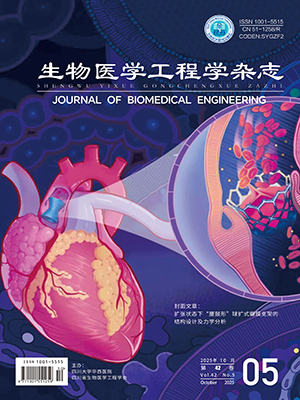| 1. |
Choudhary P S, Dandapat S. Multibranch 1D CNN for detection and localization of myocardial infarction from 12 lead electrocardiogram signa// 2021 IEEE 18th India Council International Conference (INDICON). Guwahati: IEEE, 2021: 1-5.
|
| 2. |
万学红, 卢雪峰. 诊断学. 第9版. 北京: 人民卫生出版社, 2018: 501-514.
|
| 3. |
Arif M, Malagore I A, Afsar F A. Detection and localization of myocardial infarction using k-nearest neighbor classifier. J Med Syst, 2012, 36(1): 279-289.
|
| 4. |
Acharya U R, Fujita H, Adam M, et al. Automated characterization and classification of coronary artery disease and myocardial infarction by decomposition of ECG signals: A comparative study. Inf Sci, 2017, 377: 17-29.
|
| 5. |
Fatimah B, Singh P, Singhal A, et al. Efficient detection of myocardial infarction from single lead ECG signal. Biomed Signal Process Control, 2021, 68: 102678.
|
| 6. |
Bhaskar N A. Performance analysis of support vector machine and neural networks in detection of myocardial infarction. Proced Comput Sci, 2015, 46: 20-30.
|
| 7. |
Lin Z, Gao Y, Chen Y, et al. Automated detection of myocardial infarction using robust features extracted from 12-lead ECG. Signal Image Video P, 2020, 14: 857-865.
|
| 8. |
Sraitih M, Jabrane Y, El Hassani A H. A robustness evaluation of machine learning algorithms for ECG myocardial infarction detection. J Clin Med, 2022, 11(17): 4935.
|
| 9. |
Khan R. H, Miah J., Nipun S. A., et al. A comparative study of machine learning classifiers to analyze the precision of myocardial infarction prediction// 2023 IEEE 13th Annual Computing and Communication Workshop and Conference (CCWC). Las VegasA: IEEE, 2023: 949-954.
|
| 10. |
Acharya U R, Fujita H, Oh S L, et al. Application of deep convolutional neural network for automated detection of myocardial infarction using ECG signals. Inf Sci, 2017, 415: 190-198.
|
| 11. |
Liu W, Huang Q, Chang S, et al. Multiple-feature-branch convolutional neural network for myocardial infarction diagnosis using electrocardiogram. Biomed Signal Process Control, 2018, 45: 22-32.
|
| 12. |
Jian J Z, Ger T R, Lai H H, et al. Detection of myocardial infarction using ECG and multi-scale feature concatenate. Sensors, 2021, 21(5): 1906.
|
| 13. |
Liu W, Zhang M, Zhang Y, et al. Real-time multilead convolutional neural network for myocardial infarction detection. IEEE J Biomed Health Inform, 2017, 22(5): 1434-1444.
|
| 14. |
Strodthoff N, Strodthoff C. Detecting and interpreting myocardial infarction using fully convolutional neural networks. Physiol Meas, 2019, 40(1): 015001.
|
| 15. |
Han C, Shi L. ML–ResNet: A novel network to detect and locate myocardial infarction using 12 leads ECG. Comput Meth Prog Bio, 2020, 185: 105138.
|
| 16. |
Cao Y, Liu W, Zhang S, et al. Detection and localization of myocardial infarction based on multi-scale resnet and attention mechanism. Front Physiol, 2022, 13: 24.
|
| 17. |
Baloglu U B, Talo M, Yildirim O, et al. Classification of myocardial infarction with multi-lead ECG signals and deep CNN. Pattern Recogn Lett, 2019, 122: 23-30.
|
| 18. |
Feng K, Pi X, Liu H, et al. Myocardial infarction classification based on convolutional neural network and recurrent neural network. Appl Sci, 2019, 9(9): 1879.
|
| 19. |
Ullah A, Anwar S M, Bilal M, et al. Classification of arrhythmia by using deep learning with 2-D ECG spectral image representation. Remote Sens, 2020, 12(10): 1685.
|
| 20. |
Jikui L, Ruxin W, Bo W, et al. Myocardial infarction detection and localization with electrocardiogram based on convolutional neural network. Chin J Electron, 2021, 30(5): 833-842.
|
| 21. |
Zhou B, Khosla A, Lapedriza A, et al. Learning deep features for discriminative localization// Proceedings of the IEEE Conference on Computer Vision and Pattern Recognition. Las Vegas: IEEE, 2016: 2921-2929.
|
| 22. |
Selvaraju R R, Cogswell M, Das A, et al. Grad-CAM: Visual explanations from deep networks via gradient-based localization// Proceedings of the IEEE International Conference on Computer Vision. Venice: IEEE, 2017: 618-626.
|
| 23. |
Panwar H, Gupta P K, Siddiqui M K, et al. A deep learning and grad-CAM based color visualization approach for fast detection of COVID-19 cases using chest X-ray and CT-Scan images. Chaos Solitons Fractals, 2020, 140: 110190.
|
| 24. |
Goldberger A L, Amaral L A N, Glass L, et al. PhysioBank, PhysioToolkit, and PhysioNet: components of a new research resource for complex physiologic signals. Circulation, 2000, 101(23): 215-220.
|
| 25. |
Moody G B, Mark R G. The MIT-BIH arrhythmia database on CD-ROM and software for use with it// Proceedings Computers in Cardiology. Chicago: IEEE, 1990: 185-188.
|
| 26. |
Kumar A, Tomar H, Mehla V K, et al. Stationary wavelet transform based ECG signal denoising method. ISA Trans, 2021, 114: 251-262.
|
| 27. |
Kayikcioglu I, Akdeniz F, Köse C, et al. Time-frequency approach to ECG classification of myocardial infarction. Comput Electr Eng, 2020, 84: 106621.
|
| 28. |
Rashid N, Al Faruque M A. Energy-efficient real-time myocardial infarction detection on wearable devices// 2020 42nd Annual International Conference of the IEEE Engineering in Medicine & Biology Society (EMBC). Montreal: IEEE, 2020: 4648-4651.
|
| 29. |
Lai D, Bu Y, Su Y, et al. Non-standardized patch-based ECG lead together with deep learning based algorithm for automatic screening of atrial fibrillation. IEEE J Biomed Health Inform, 2020, 24(6): 1569-1578.
|
| 30. |
姜宇琛, 张月, 茶兴增, 等. 基于多层丝网印刷柔性生物电干电极的单导联心电胸带. 中国生物医学工程学报, 2023, 42(5): 636-640.
|
| 31. |
Bu Y, Hassan M F U, Lai D. The embedding of flexible conductive silver-coated electrodes into ECG monitoring garment for minimizing motion artefacts. IEEE Sens J, 2020, 21(13): 14454-14465.
|




